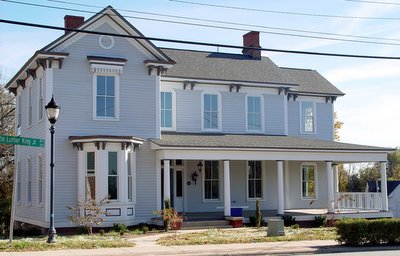Jason Hardin's Fast Forward column in today's N&R (not posted) puts its finger on why there's relatively little pedestrian traffic in many places downtown:
Many streets are wide, multi-lane routes with one-way traffic. This tends to encourage higher speeds. And that, in turn, helps to make roads such as Market, Eugene, and Edgeworth streets and Friendly Avenue unpleasant to walk along.
That's certainly been my experience: those streets have sidewalks, but the pedestrian experience on them is pretty bleak.
I remember when my hometown of Davenport, IA instituted multi-lane one-way streets downtown in the early 70's in an effort to help its struggling downtown. Didn't work: everyone just drove through really fast.
As Barry Cullingworth says about those road projects,
Paradoxically, these began as an attempt to rescue the cities from decline: they were seen as providing easy access to the city. Unfortunately, it was not perceived that they might equally well provide easy exit.
--Planning in the USA (Routledge: 2003) p. 34.
Actually, Greensboro has had some recent successes in accommodating both cars and pedestrians.
The East Market Street corridor project-- for which they actually
narrowed the street -- and Southside both have really nice places to walk because the planners included design elements that make pedestrians feel good.
 Here on East Market you can see that they included landscaped "curb lawns" and planted trees in them, which give pedestrians a sense of protection from passing cars. In the picture below, from Southside, a decorative brick border is used for a similar effect because there's less sidewalk to work with.
Here on East Market you can see that they included landscaped "curb lawns" and planted trees in them, which give pedestrians a sense of protection from passing cars. In the picture below, from Southside, a decorative brick border is used for a similar effect because there's less sidewalk to work with.
The border not only looks nice, it keeps you from feeling like you're walking really close to the street (even though you are). On-street parking helps, too.
 This crosswalk on E. Market makes crossing a lot less daunting than it used to be, and the brick piers give a sense of safety from fast-moving cars.
This crosswalk on E. Market makes crossing a lot less daunting than it used to be, and the brick piers give a sense of safety from fast-moving cars.
 Dogs like them, too. (And didn't they do a great sit-stay for the photo?)
Dogs like them, too. (And didn't they do a great sit-stay for the photo?)
Both of these award-winning projects originated in Greensboro's Department of Housing and Community Development, run by Andy Scott and his talented staff.
I wonder whether any new projects like these will be generated at the political level by our new city council, rather than at staff level as has been the case so far.













